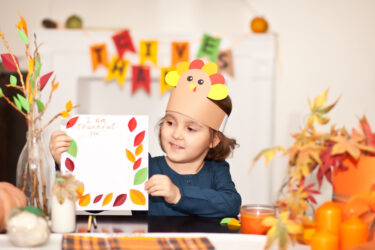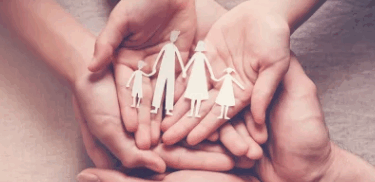“Can I stay home with you today mom?” “Can you pick me up early?” “Do I have to go to school today?”
These were questions that my daughter, then 3, was asking me each day. At first, I thought she just wanted to stay home and snuggle, but then I wondered if it could be more. She was constantly twirling her short hair — was she trying to avoid going to daycare? Was she experiencing anxiety … at age 3?
NORMAL ANXIETY
Amanda Porter, psychiatric nurse practitioner at the Lindner Center of HOPE in Mason, says it’s important to understand that experiencing occasional anxiety is normal for people of all ages. Anxiety is the completely normal reaction to stress, and it keeps us safe in certain situations.
If you want to perform well, you may feel anxious in anticipation of the event. Once the perceived threat has passed, the anxiety goes away. It’s normal for kids to go through phases of anxiety as they grow. These phases are usually short lived and harmless:
NORMAL ANXIETY
- Fear of strangers: typically 7 – 12 months
- Animals, monsters, loud noises, the dark: typically 1 – 5 years old
- Getting into trouble, being alone, getting hurt: typically 6 – 12 years old
- Peer acceptance, social embarrassment and school performance: typically 12 – 18 years old
SIGNS OF ANXIETY
Anxiety in children can be difficult to recognize since it’s an internal culprit. Outwardly, it can present in many ways. Since little kids can’t articulate the cause of their anxiety, parents need to be observant and aware of personality changes.
Signs that your child may be experiencing anxiety include:
- Change in behavior
- Excessive worry/fear
- Increased heartrate
- Irritability
- Disrupted sleep
- Headaches, chest pain, nausea
- Nervousness around change
- Difficulty concentrating
- Restlessness/fatigue during waking hours
- Asking to avoid certain activities
- Excessive hair twirling
- Fingernail/lip biting
Sometimes helping kids manage their anxiety is easy, but different temperaments of children and the way parents handle situations set the precedent. Sometimes parents have to go farther with their children to understand the “triggers” of their anxiousness. One big trigger is a change in day to day life.
Katie Strubbe, M.A., a local behavior intervention coach, recommends you “create a routine and prep your child for new environments. Let them know that change is coming.” Strubbe says if you recognize that your child doesn’t like going to new activities, for example, you can review what the next day looks like for your child the night before.
Kids need to know what’s going on day to day and it doesn’t help with anxiety if parents simply spring things on them without giving them time to adjust and “see” what’s coming up. Helping your child recognize that a transition is coming helps them prepare in order to reduce anxiety about change.
Also, learn to pay attention to your child’s emotions; ups and downs can alert you to stressors in his life.
Anxious kids benefit from certain de-stressing techniques that many anxious adults know well: Deep breathing, mindfulness, calming music, yoga and exercise.
WHEN TO SEEK SUPPORT
If your child seems to be overly anxious and there’s no immediate issue, or if he continues to worry about a situation long after it occurs, he’s probably experiencing anxiety. When this sort of behavior becomes chronic and unmanageable, you will need help.
You can work through it as best you can with patience and understanding, but you can get good behavioral guidance from your pediatrician.
Porter says that parents can benefit from keeping a “mood diary” of an anxious child. This is an objective record of things going on in your child’s life to help you grow in awareness of his anxiety and the things that cause it. If symptoms are present for a six-month duration or longer, according to the American Psychiatric Association, your child may have an anxiety disorder.
Anxiety disorders are “excessive and unrealistic worry about everyday tasks or events, or may be specific to certain objects or rituals,” according to the Centers for Disease Control. And, according to the 2015 Child Mind Institute Children’s Mental Health Report, one in eight children has an anxiety disorder. When anxiety becomes excessive, it interferes with daily living. Anxiety affects school performance, relationships and increases negative behaviors. The root of anxiety disorders are unknown, but experts concur that they involve a combination of factors including genetic, environmental, psychological and developmental.
HELPING YOUR CHILD COPE
If your child is experiencing anxiety at home, he is likely experiencing anxiety at school, too. It may be causing your child to struggle socially or academically. If you have concerns abut your child at school, e-mail his teacher.
Terri Doerr, a parent mentor at Lakota Local Schools suggests being “as proactive with your child’s needs as possible. Work as a team to come up with strategies to try at school and home to make your child as comfortable as possible. Sometimes, students with anxiety just need gentle reassurance they are safe.”
Doerr also recommends making sure his teacher know what behaviors your child displays when anxious and what strategies they can implement to help reduce his anxiety.
Also, ask your child’s teacher to keep a record of behavior changes at school so you can share it with your child’s doctor if needed.
ANXIOUS PARENTS, ANXIOUS KIDS
Raising a child with anxiety can be difficult on you — especially if you’re anxious yourself. It’s true that anxious parents can model anxious behavior to their kids and pass it on, but some anxious kids come from adults who have normal levels of anxiety.
Remember that your child’s anxiety is not a reflection of your parenting skills.
Doerr says that “when dealing with an anxious child, remember to take care of yourself.
Your energy level is just as important as your child’s, so make sure you get enough sleep, take deep breaths to calm and center yourself and focus on the positive attributes of your child.”
After extensive research on child anxiety, I decided to visit my daughter’s pediatrician. My husband and I implemented interventions. A year later, I’m happy to report my child no longer asks to skip school, her hair twirling has decreased, and her biggest “worry” now is how she will style her shoulder length hair!
THINGS TO SAY TO AN ANXIOUS CHILD
Navigating anxiety is an essential life skill. Here are simple things you can say that can make anxiety less powerful over your child and help him to realize you are there to help.
- “I love you, you are safe.”
- “Can you draw it?”
- “Say, ‘I can do this.’”
- “What’s the worst thing that can happen?”
- “I get scared/worried/anxious sometimes, too. It’s not fun.”
- “Let’s pull out our calm-down checklist.”
- “You are not alone in how you feel.”
- “Let’s take a deep breath.”
- “This feeling will pass.”
- “We’ll get through this together.”
Source: PsychCentral
FREE APPS
Turn your phone into a handy tool to help you manage your child’s anxiety.
BREATHE, THINK, DO SESAME APP
BREATHING BUBBLES
DREAMYKID APP
HEADSPACE
MINDSHIP
RELAX MELODIES
SMILING MIND
STOP, BREATHE, AND THINK KIDS





